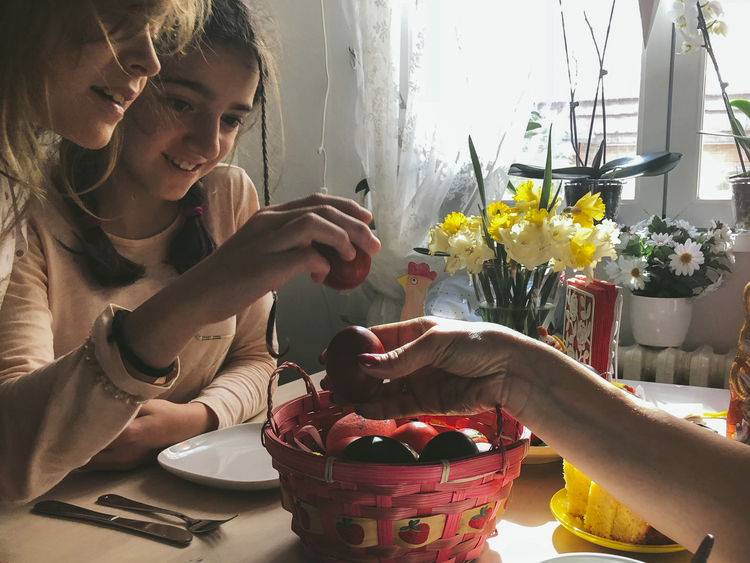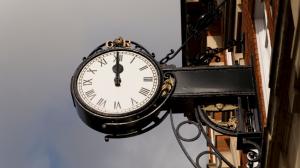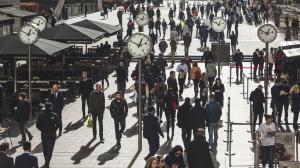
Best Comet of 2025?
C/2024 G3 (ATLAS) has already become very faintly visible to the naked eye for observers in the Southern Hemisphere.
Many Orthodox churches base their Easter date on the Julian calendar, which often differs from the Gregorian calendar that is used by many western countries. Therefore the Orthodox Easter period often occurs later than the Easter period that falls around the time of the March equinox.

It is common to crack or smash painted eggs on Orthodox Easter Day.
©iStockphoto.com/vgajic
NEWS: Why is Orthodox Easter so late?
Millions of Orthodox Christians worldwide, including about six million in North America, observe Easter, also known as Pascha, each year. It is estimated that there are more than 250 million Orthodox Christians in the world.
In Lebanon, many Orthodox Christians attend a church liturgy at Easter, whether it is on Sunday morning or midnight liturgy between Holy Saturday and Easter Sunday. On Easter Sunday, many families hold a special lunch consisting of turkey or chicken stuffed with nuts and served with rice. The afternoon is spent visiting friends and family members. Many homes have maamoul (cookies) on a plate with other delicacies such as chick peas covered with sugar and sweet almonds.
In Bulgaria, many worshippers celebrate outside churches after midnight liturgy, carrying candles to symbolize the resurrection of Jesus Christ. Painted eggs are cracked or smashed and richly-painted Orthodox churches are filled with clouds of incense and choir songs.
In Greece, Easter Sunday is also a widely celebrated occasion. Lambs are roasted on a spit and the provision of wine is abundant. The roasted lamb is served in honor of Jesus Christ, who was sacrificed and rose again on Easter. Lamb is the most traditional Greek Easter food. Red-dyed eggs are cracked against each other and the person with the last remaining uncracked egg will have good luck. Easter Sunday is a time of festivity and people eat, chat or dance throughout the night.
On the island of Crete, many villages prepare for a bonfire effigy of Judas Iscariot, who betrayed Jesus Christ, as described in the New Testament of the Bible. In the lead up to the bonfire event, people gather sticks and branches to prepare to burn the effigy.
Around the world, many Orthodox Catholic Churches, including the Greek and Russian Orthodox churches, hold Easter liturgies during the Easter period according to the Julian calendar. Families unite and join in Orthodox Easter activities, festivities and traditions.
Countries that officially observe the Orthodox Easter period include: Bulgaria, Cyprus, Greece, Lebanon, Republic of Macedonia, Romania, Russia, and Ukraine. There are no federal Orthodox Easter public holidays in countries such as Australia, Canada, the United Kingdom, and the United States. However, it is a time for families and friends of the Orthodox Christian faith to gather together and to celebrate the Orthodox Easter period.
Easter is not a federal holiday in Jordan, although many Orthodox Christians are pushing to make it an official holiday. There have been petitions calling for the government in Jordan to make Easter an official public holiday. Jordan has a population of about six million people, and about six percent consists of Christians while about 92 percent consists of people of the Sunni Muslim faith.
In Lebanon – a country with a population of nearly 60 percent being Muslim and about 39 percent being Christian – Easter Sunday and Good Friday are public holidays.
Orthodox Easter, or Pascha, is usually observed after the Jewish Passover, in keeping with early Church traditions. The date is calculated as the first Sunday after the first full moon following the spring equinox, according to the Julian calendar. In rare cases, Pascha and Passover can overlap; this happened in 2010, when Orthodox Easter Sunday fell on April 4th, while Jewish Passover in Israel lastet until April 5th of that year.
The rules for calculating the Orthodox Easter date go back to the Council of Niceaea in 325 CE. The council established that Easter would be held on the first Sunday after the first Full Moon occurring on or after the March equinox. From that point forward, the Easter date depended on the ecclesiastical approximation of March 21 for the March equinox. Easter is delayed one week if the full moon is on Sunday, which decreases the chances of it falling on the same day as the Jewish Passover.
Although the Council of Nicaea established the Easter date for churches around the world, not all Christian churches observe Easter according the Gregorian calendar. Many Orthodox churches still observe Easter in accordance with the Julian calendar.
In the Orthodox circles, tensions exist between New Calendarists – those who use the revised Julian calendar for calculating the feasts of the ecclesiastical year – and Old Calendarists – those who continue to use the traditional Julian calendar. The calendar question reflects the dispute between those who wish to synchronize with the modern Gregorian calendar and those who wish to maintain the traditional ecclesiastical calendar based on the Julian calendar.
There have been a number of proposed Easter date reforms. In 1997 the World Council of Churches proposed a reform to solve the Easter date difference between churches that observe the Gregorian calendar and those that observe the Julian calendar. So far, this reform has not been implemented.
Easter celebrations in Orthodox Christian communities usually include a spit-roast lamb dinner and a display of hard-boiled eggs, dyed red to symbolize the blood of Christ. The egg was an important symbol in the mythologies of many early civilizations and was also connected with the springtime fertility rituals. Many Greeks rap their eggs against their friends' eggs and the owner of the last uncracked egg is considered lucky. The red eggs are usually prepared on Holy Thursday in countries such as Greece. According to tradition, the Virgin Mary dyed eggs red to celebrate the Resurrection of Christ and to celebrate life. A traditional Easter dinner may consist of red-dyed eggs baked into a braided loaf of bread, spit-roasted, herb-perfumed baby lamb, and assorted vegetables.
One of the most common Christian symbols associated with Easter is the lamb. It is often depicted with a banner that bears a cross, and it is known as the Agnus Dei, meaning "Lamb of God" in Latin. The symbol’s origin relates to the Jewish Passover. In ancient times the Jews sacrificed a lamb in the course of the festival. The early Christians associated the sacrifice of the lamb with Jesus Christ's sacrifice on the cross. They connected the joyous Passover festival, which celebrates the liberation of Jewish people from years of bondage in Egypt, with the liberation from death represented by the resurrection of Jesus Christ.

C/2024 G3 (ATLAS) has already become very faintly visible to the naked eye for observers in the Southern Hemisphere.

How does the 12-hour clock system work? Is midnight 12 am or 12 pm?

Why do many countries set the clocks back and forth an hour twice a year?

Why are there 12 months? How long are they, and what do the month names mean?